Types of Black and White Bugs (With Pictures) – Identification Guide

Black and white bugs come in various shapes and sizes. From the common hairy rove beetle, banded alder borer to the invasive spotted lanternfly and destructive carpet beetle, it seems black and white bugs are everywhere. Black and white insects, beetles, and ladybugs can be fascinating.
Many of these bugs are beneficial insects that help control pest populations. However, other black and white insects and arthropods can enter homes and become nuisance pests. Therefore, identifying types of black and white bugs is essential to know which are useful bugs and which are pesky critters.
This identification guide showcases different types of black and white bugs. To help identify the six-legged creepy crawlies, pictures and detailed descriptions will help you recognize the white and black bugs in your garden, home, or outdoor spaces.
How to Identify Black Bugs with White Spots
To identify black bugs with white spots, look carefully at the shape and size of the insect, its markings, and color. Observe if it has wings, how many legs it has, the size of its antennae, and check for any patterns or stripes. Additionally, pictures of black and white bugs can help with identification.
Many refer to all small annoying black and white insects as “bugs.” However, it is important to note that not all black insects with white spots are “true bugs” in scientific terms. True bugs are six-legged insects belonging to the order Hemiptera. These insects have mouthparts to bite into plant tissue and suck plant juices.
However, the article uses the term black and white “bugs” to refer to all six-legged insects with black and white markings, regardless of if they are “true bugs” or not.
Common Black Bugs with White Spots
Common black bugs with white spots include the eastern click-eyed beetle, flea beetles, carpet beetles, and the hairy rove beetle. In North America, spotted lanternflies—non-native black bugs with white spots—have become a significant pest. The white-spotted bugs cause damage to ornamental shrubs, trees, and fruit trees.
Black Bugs With White Spots (With Pictures) – Identification Guide
Let’s look in detail at some of the most common black bugs, beetles, and other insects with white spots.
Eastern Eyed Click Beetle (Alaus oculatus)
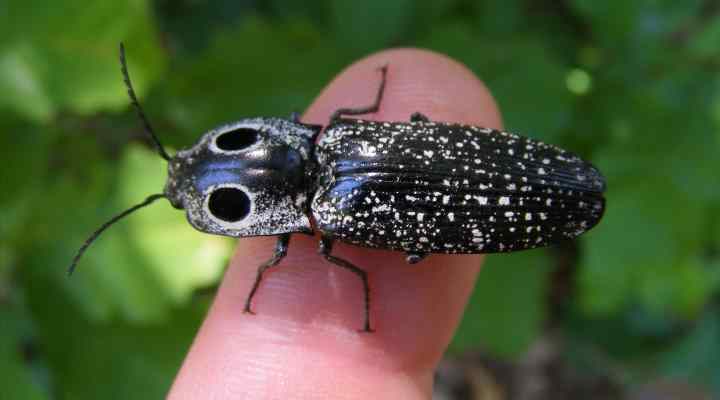
The eastern eyed click beetle has a slender black body with white specks and unusually large eye-like spots
The eastern-eyed click beetle is a large black bug with white spots. Its distinctive identifying features are its conspicuous eyespots, white speckles on black elytra (wing covers), and an elongated, oval-shaped body. The white-spotted black beetle measures 1.0” to 1.8” (25 – 45 mm) long.
Black and white click beetles get their name from their habit of jumping out of danger and making a clicking noise. This species of black beetle is native to North America. It’s commonly found feeding on nectar, plant juices, and wood-boring beetles.
Black Bug With White Spots Identification
The Eastern-eyed click beetle is a large beetle with a black body, a scattering of tiny white dots, and prominent eye-like spots on its pronotum.
White Spotted Sawyer (Monochamus scutellatus)
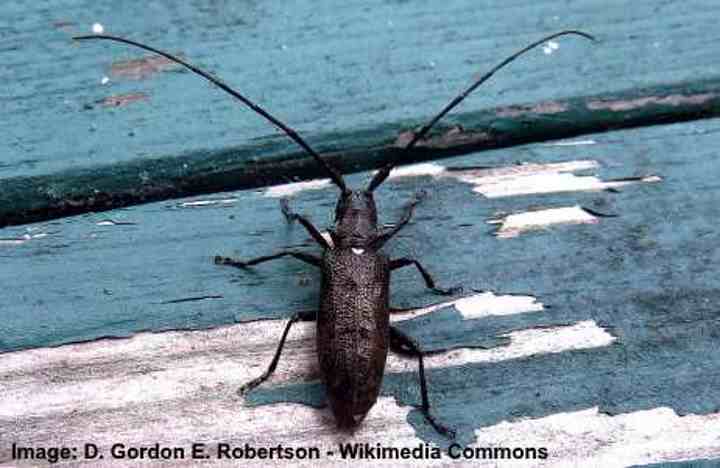
The white-spotted sawyer beetle has long antennae and white dot on its black body
The white spotted sawyer is a large-bodied black bug with a distinct white heart-shaped spot at the base of its thorax. Other identifying features of this black bug are its super-long arching antennae and stocky legs. Its long antennae can be twice as long as its body.
The black beetle can measure 0.70” to 1.0” (18 – 25 mm) long. It is found in evergreen forests in North America, where it damages pine, fir, and spruce trees by boring into the timber and causing holes.
Black Bug With White Spots Identification
The white-spotted sawyer is a large black beetle with long antennae and a solitary white spot on its back.
Eight-Spotted Flea Beetle (Omophoita cyanipennis)
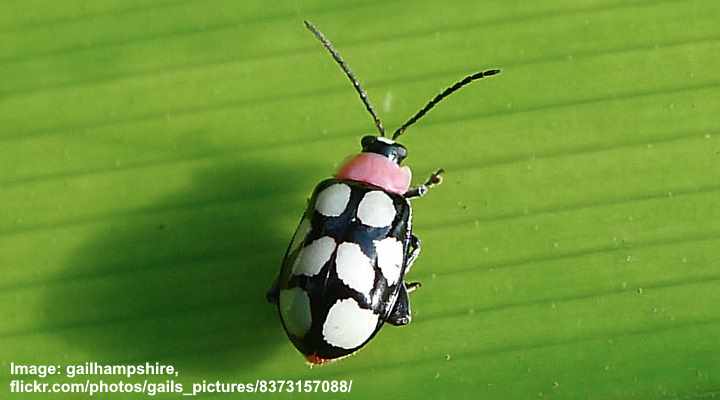
The eight-spotted flea beetle is identified by its large white spots on its black body and pink thorax
The eight-spotted flea beetle is a small black bug with large white spots on its elytra. The white-spotted black beetle is also identified by its pinkish or orange thorax, small black head, and two antennae. The small beetle measures 0.31” to 0.47” (8 – 12 mm) long.
This black beetle with its white spots gets its name from its jumping behavior, similar to fleas. It is known for its ability to jump away quickly when disturbed. The eight-spotted flea beetle is a pest to many plants, including cabbage, broccoli, and other cruciferous vegetables. It feeds on the leaves, skeletonizing the foliage.
Black Bug With White Spots Identification
The eight-spotted flea beetle is easily identified by its small size, black color, and eight distinct white spots on its wing covers.
Desert Cockroach (Therea petiveriana)
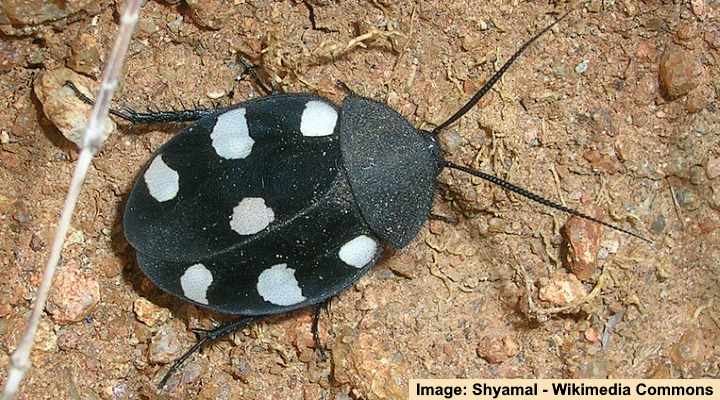
The desert cockroach has a black rounded body with seven white spots
The desert cockroach is a black bug with white spots found in dry, hot, arid regions. It is characterized by its rounded, oval body, thin antennae, and six small legs. The white-spotted cockroach is well-adapted to its arid environment and can survive for long periods without water.
Other names for the desert cockroach include seven-spotted cockroach and Indian domino cockroach—referring to its black color and seven white dots on its wing covers. The black and white cockroach measures 1.0” to 1.4” (25 – 35 mm) long. It’s one of the few cockroaches described as graceful and beautiful.
Black Bug With White Spots Identification
The desert cockroach is a large black cockroach with seven white spots on its oval body.
Black and White Bugs (With Pictures) – Identification Guide
Many species of black bugs have varying patterns, not just white spots, to help identify them.
Banded Alder Borer (Rosalia funebris)
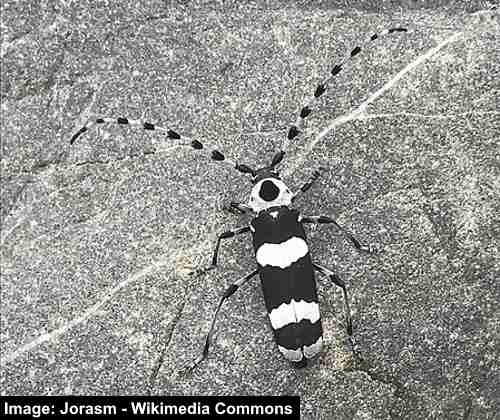
The banded alder borer is a black beetle with white bands, striped antennae and black dot on its white thorax
The banded alder borer is a striking black and white longhorn beetle. It’s one of the most distinctive black beetles with white bands across its back and its antennae. Additionally, the beetle has a white thorax with a large black spot in the middle. The banded alder borer measures up to 1.5” (38 mm) long.
These beetles are commonly found in alder, oak, maple, and willow trees. Despite its large size, this black and white borer beetle is not dangerous to humans or a significant pest in woodlands.
Black and White Bug Identification
The banded alder borer is a beautiful beetle with a long black body and distinctive white bands across its elytra and on its antennae. It has a black head and black and white thorax.
Hairy Rove Beetle (Creophilus maxillosus)
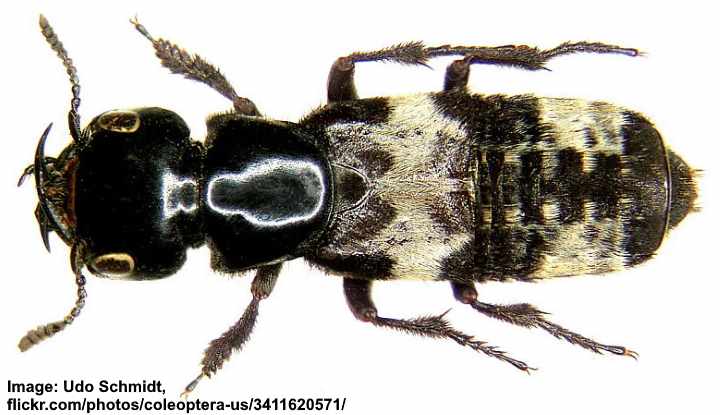
The wing covers of the hairy rove beetle are covered with black and white short, dense hair
The hairy rove beetle is one of the most common black and white bugs in the Eastern United States. The shiny black beetle is characterized by its hairy appearance, and creamy-white patches across its back. The black and white hairy rove beetle grows 0.47” to 0.71” (12 – 18 mm) long.
These beetles are commonly found feeding on dead animals or rotting plant material. Therefore, they have a beneficial role in forest and woodland ecosystems.
Black and White Bug Identification
The hairy rove beetle has black head and thorax with black and white hairy elytra.
Black and White Carpet Beetle (Anthrenus verbasci)
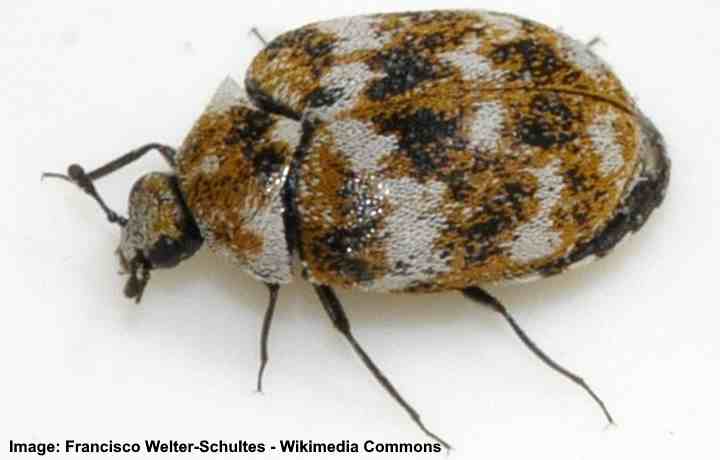
The tiny carpet beetle larvae feed on natural fibers and has black, white and brown-yellow patches on its body
The varied carpet beetle is a tiny oval-shaped house bug with mottled black, white and yellowish patterning on its wing covers. The tiny beetle can be the size of a poppy seed, varying in length from 0.07” to 0.14” (1.7 – 3.5 mm). These beetles have a rounded body, six legs, and two antennae.
Adult carpet beetles may be found indoors on window sills or near other light sources. Carpet beetle larvae are destructive pests that feed on wool, feathers, and other natural fabrics. They cause holes in clothing, drapes, and carpets like cloth-eating moths.
Black and White Bug Identification
The carpet beetle is a small beetle identified by its rounded shape and black, brown, white, and yellow mottled patterns.
Spotted Lanternfly (Lycorma delicatula)
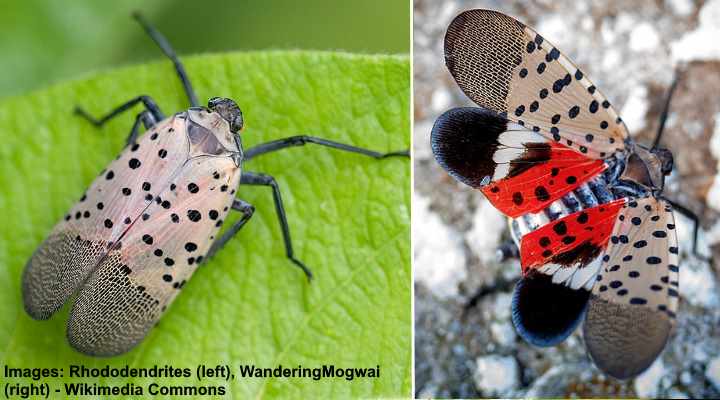
The spotted lanternfly has pale wings covered in black dots, with black, white and red underwings
The spotted lanternfly is a destructive pest with pinkish-white wings covered in black spots. The adult spotted lanternfly is identified by its black head, pale, black-spotted fore wings with gray tips and red hind wings. Its distinctive abdomen has black and white bands. Spotted lanternflies measure 1” (25 mm) long. The nymphs of the spotted lanternflies have a black body and white spots in their early life instars.

spotted lanternfly nymphs
The flying critters cause significant damage to ornamental plants and crops. The non-native spotted lanternfly bites into plant tissue and sucks the sap. This causes the plants to weaken and die.
Black and White Bug Identification
The spotted lanternfly is a distinctive insect with black and grayish-beige wings, black spots, and a striped black and white underbelly. It also has vibrant red hind wings with black spots.
Cottonwood Borer (Plectrodera scalator)

The black and white cottonwood borer is a large beetle with long black antennae
The cottonwood borer is a large longhorn black beetle with distinctive white markings on its elytra. The black and white bug grows to 1.6” (40 mm). Apart from its black-and-white coloration, other identifying features are its long black antennae, whitish tiny hairs forming leopard-like markings, and stout legs.
The cottonwood borer is commonly found in the eastern United States and is known for its destructive feeding habits. The larvae of this beetle tunnel into the wood of young cottonwood trees, causing damage to the tree’s structure. Adult beetles feed on the bark and foliage of cottonwood trees.
Black and White Bug Identification
The cottonwood borer is a large beetle with an elongated body covered in black and creamy-white markings. Like all longhorn beetles, it has a pair of antennae longer than its body.
Asian Long-Horned Beetle (Anoplophora glabripennis)
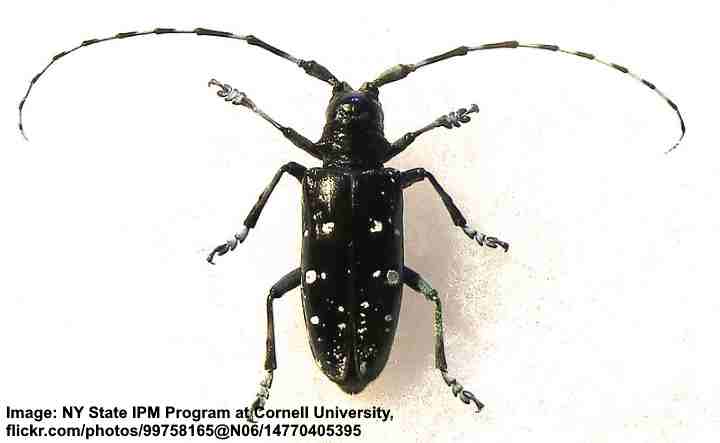
The Asian long-horned beetle has a black body with white dots and is considered a serious pest
The Asian long-horned beetle is a large black bug with white spots and long antennae with black and white bands. The white-spotted black beetle has a triangular body. Its black elytra have irregular patterns of white dots, making it look like a starry sky at night. This large invasive black beetle measures 0.67” to 1.54” (17 – 40 mm) long.
In the United States, the Asian long-horned beetle is considered a serious pest that infests many trees such as maple, elm and willow.
Black and White Bug Identification
The Asian long-horned beetle is a large black beetle with long antennae and distinctive white spots on its black elytra. Additionally, it has long black and white banded antennae that are longer than its body.
Mediterranean Spotted Chafer (Oxythyrea funesta)
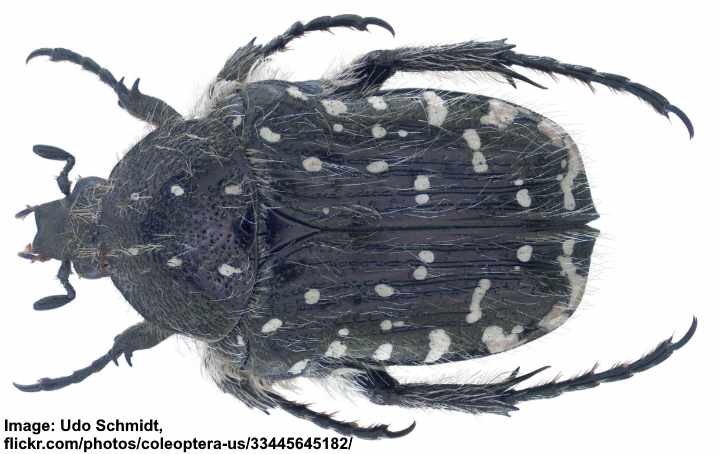
The Mediterranean spotted chafer has a black body with white spots and white hair
The Mediterranean spotted chafer is a small bug with a shiny black body and distinct white spots on its elytra. The black beetle is covered with white hairs that come off as it gets older. It has the shape of a coffee bean and measures 0.31” to 0.47” (8 – 12 mm).
These black and white beetles are often found on flowers, feeding on pollen and nectar, but they can also damage buds and flowers.
Black and White Bug Identification
The Mediterranean spotted chafer is identified as a small black beetle with small white dots on its thorax and elytra.
Twenty-Spotted Lady Beetle (Psyllobora vigintimaculata)
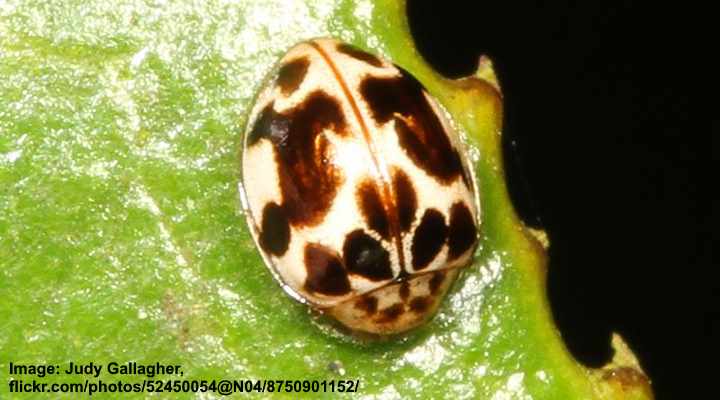
The twenty-spotted lady beetle has creamy white body with brown-black patches
The twenty-spotted lady beetle is a small, round ladybug with distinctive brownish-black spots on creamy-white elytra. As its name suggests, the beetle has 20 distinct dark spots of varying size and shape. The small beetles measure 0.07” to 0.12” (1.75 – 3 mm).
The twenty-spotted lady beetle is a beneficial insect as it feeds on aphids and other small insects that can damage crops. It is commonly found in gardens and agricultural fields.
Black and White Bug Identification
The twenty-spotted lady beetle is a small creamy-white beetle with 20 dark brown, almost black spots on its elytra.
Ironclad Beetle (Zopherus nodulosus haldemani)
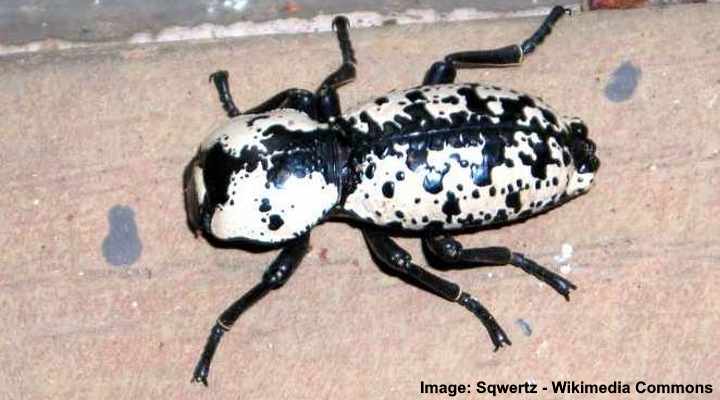
Ironclad beetles have distinctive black patterns on their white body
The ironclad beetle is a large black and white bug known for its tough exoskeleton. The beetle is mainly white with black patterns on its elytra, head, and thorax. The blotchy patterns give the native beetle a distinctive appearance compared to other black beetles. Ironclad beetles measure 0.62” to 1.9” (30 mm) long.
Adult ironclad beetles feed on lichens growing on oak tree trunks. These beetles can be found in wooded areas of Texas.
Black and White Bug Identification
The ironclad beetle is identified as a large black insect with distinct white and black blotches on its wing covers. It also has a tough exoskeleton, providing strong protective armor.
Flea Beetles (Disonycha)
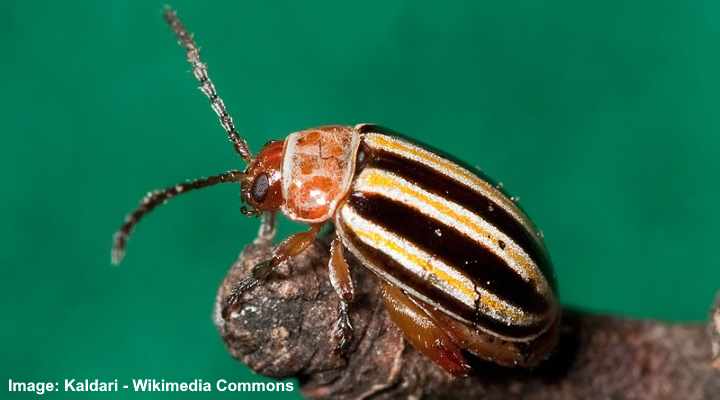
Disonycha admirabila flea beetle
Many species of flea beetles are black and white striped beetles known for their jumping ability like fleas. The small oval beetles are characterized by their banded wing covers, orange thorax, and reddish brown head. They also have clubbed antennae; some may have legs the same color as their heads.
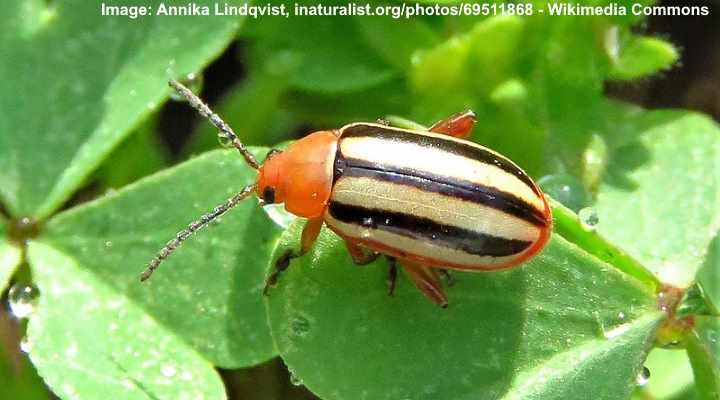
Disonycha leptolineata flea beetle
The black and white striped beetles measure 0.20” (5 mm) long.

Disonycha procera flea beetle
Black and White Bug Identification
Flea beetles, specifically the Disonycha genus, are small beetles that typically have white and black stripes on their elytra.
Eastern Beach Tiger Beetle (Habroscelimorpha dorsalis)
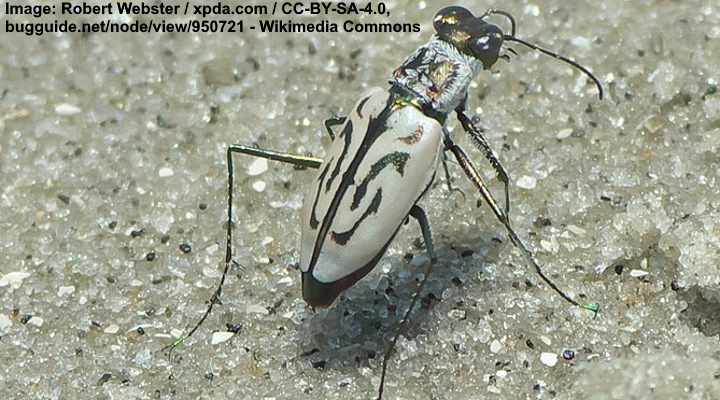
The eastern beach tiger beetle has whitish-gray body with black patterns
The eastern beach tiger beetle is a small whitish-gray predatory beetle with black markings on its wing covers. The unusual beetle is identified by its long spindly black legs, oval head with large compound eyes, and metallic green or blue coloration. As its name suggests, the white-gray, black-marked bug lives in coastal regions and sand dunes.
The eastern beach tiger beetle grows 0.50” to 0.60” (13 – 15 mm) long.
Black and White Bug Identification
The eastern beach tiger beetle is identified by its black markings and central black stripe on its off-white elytra. You will commonly find the species in sandy coastal areas.
Calligrapha Beetles (Calligrapha spp.)
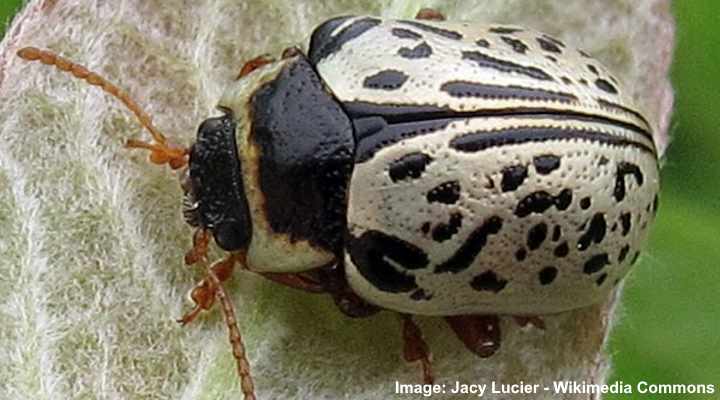
The common willow calligrapha beetle (Calligrapha multipunctata)
Many small beetles in the genus Calligrapha are classified as small black and white rounded bugs with distinctive black markings. The unusual black patterns on their white elytra resemble calligraphy, hence the name. The black and white beetles typically measure 0.20” to 0.35” (6.5 – 9 mm) in length.
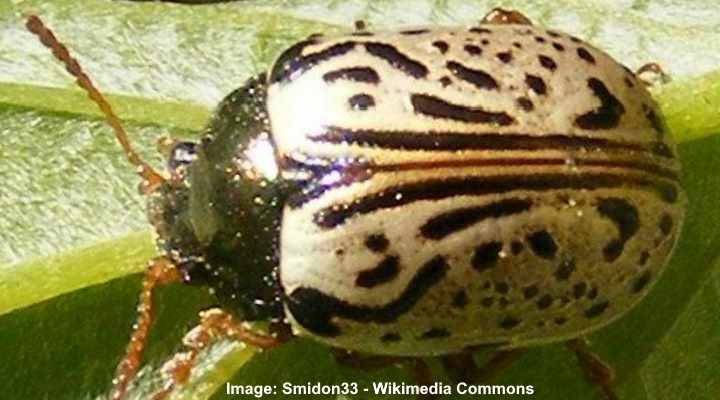
The dogwood calligrapha beetle (Calligrapha philadelphica)
You will commonly find the tiny black and white beetles in woodlands where deciduous trees grow, feeding on the leaves. Calligrapha beetle larvae cause damage as they skeletonize leaves on host plants, creating shot holes in them.
Black and White Bug Identification
The small calligrapha beetles have shiny white elytra with black stripes and spots in a unique calligraphy-like pattern.
Common Asparagus beetle (Crioceris asparagi)
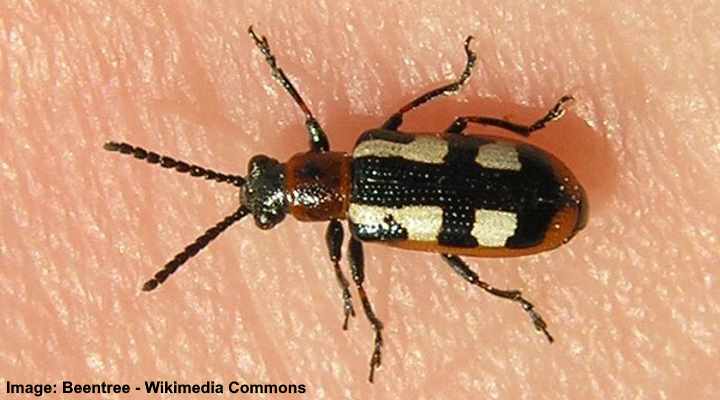
The common asparagus beetle has a black body with white square patches and reddish thorax
The common asparagus beetle is a small, oval-shaped elongated bug with a shiny black body, three square white patches on its sides, and a reddish thorax. The colorful black, white, and red beetle measures 0.23” to 0.37” (6 – 9.5 mm) long.
These beetles are a common pest of asparagus plants and can cause significant damage if left untreated.
Black and White Bug Identification
The common asparagus beetle is a small beetle with metallic blue-black wing covers with creamy-white spots and red borders.
Related articles:
